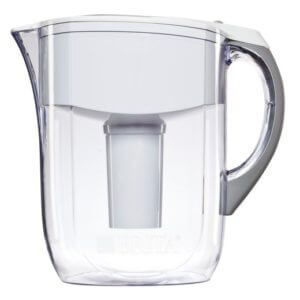The following is applicable to almost any coffee machines, whether it’s a simple coffee maker you got from the electromart, or a commercial machine. This guide is particularly for the residents in Singapore where water is clean with slight hardness. If you are a reader from other countries, we will suggest making your own research but you can draw a few reference from our article which should benefit you.
Most users primarily focus on cleaning the brewing mechanism of their coffee machine, identified as Area 1 below. Problems encountered in this area are typically minor. Most complications associated with the grouphead or wands are related to normal wear and tear, and are readily serviceable. Occasionally, minor leaks or slight irregularities in pressure may occur; however, these issues generally do not render the machine irreparable.
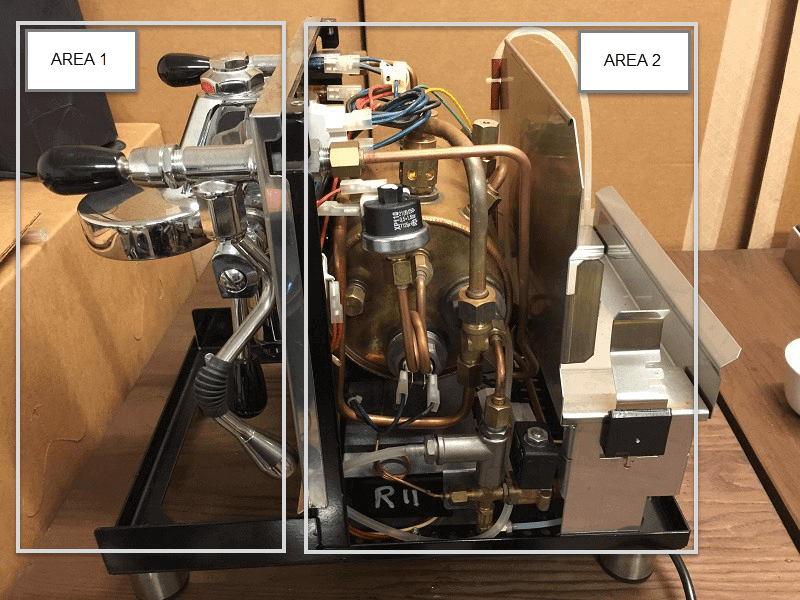
Many individuals often overlook the boiler and water circuitry, referred to as Area 2 above. Experienced espresso machine technicians unanimously agree that water softening is the most critical maintenance step for any coffee machine. In complex boiler-heated espresso machines, damage caused by limescale is typically not covered by the warranty, which is why we will strongly advocate on water softening. We will also explain to you why will descaling not work but often cause more serious issues.
Why do we need to soften?
Water contains minerals, some of which form limescale, primarily composed of calcium sulfate (CaSO₄), calcium carbonate (CaCO₃), and magnesium carbonate (MgCO₃). Limescale tends to accumulate and solidify, growing larger until it obstructs water passages or prevents seals from closing properly. This can lead to partial or complete blockages, causing sufficient damage to result in machine failure. Issues such as pressure or heating problems may arise, potentially leading to the failure of other components as well.
The presence of limescale in one area is often indicative that the entire water network and many connected components are affected, which can lead to various issues and result in costly repairs. Even with a complete overhaul, there is no guarantee that a technician can entirely remove all limescale and prevent future problems.
Even the most robust components in a machine can only function effectively if they are not obstructed. The best preventative measure a user can take is to maintain soft water in the system. Machines kept free from limescale can operate for decades with minimal repairs. It is far more cost-effective and simpler to prevent the buildup of limescale than it is to remove it after the fact.
Here are some photos of limescale formation on espresso machines used in Singapore.
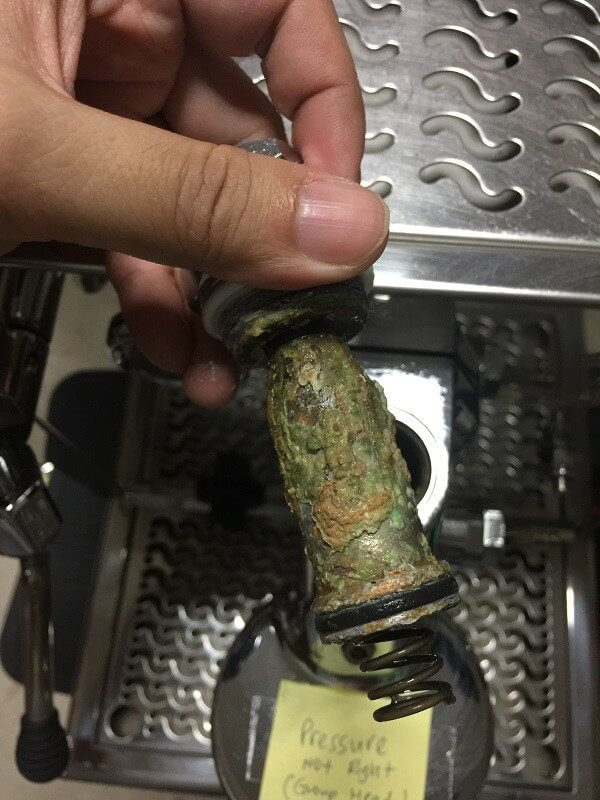
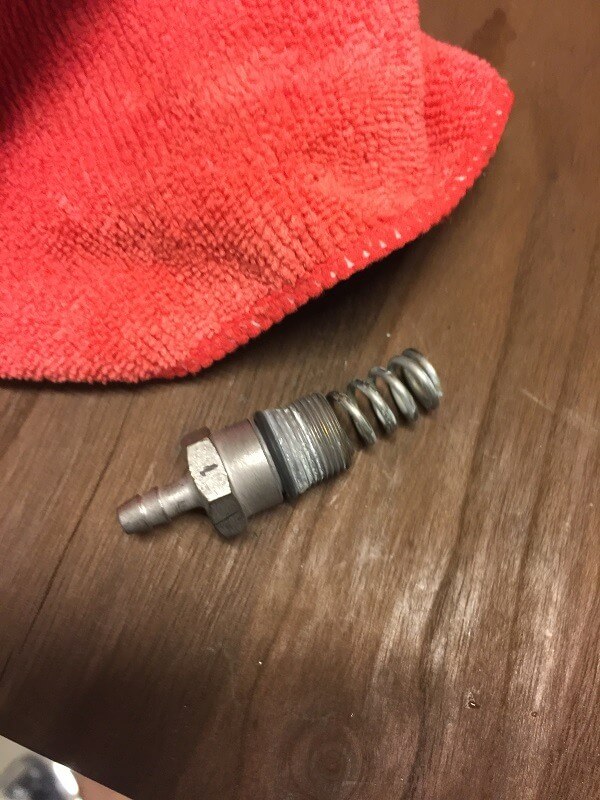
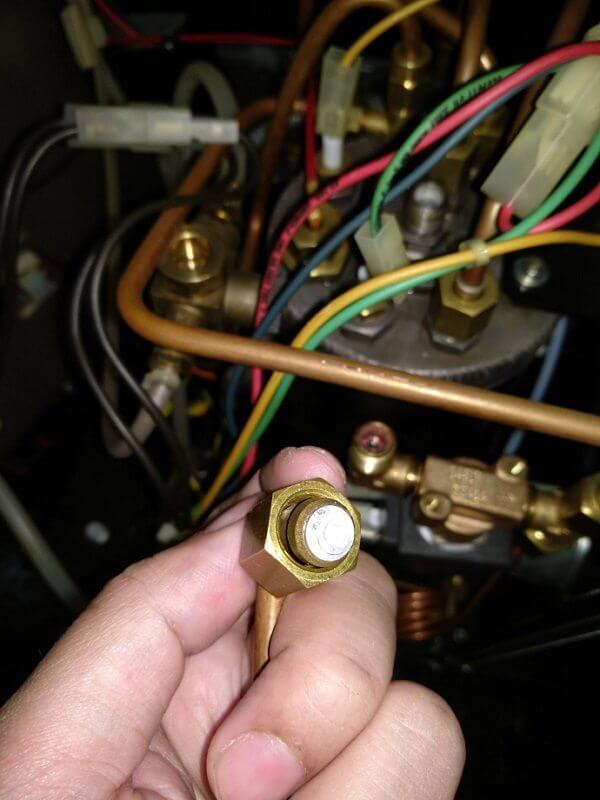
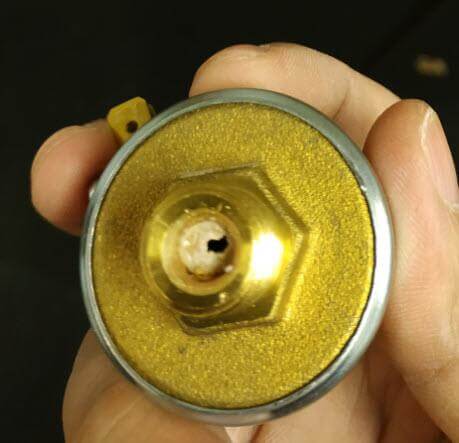
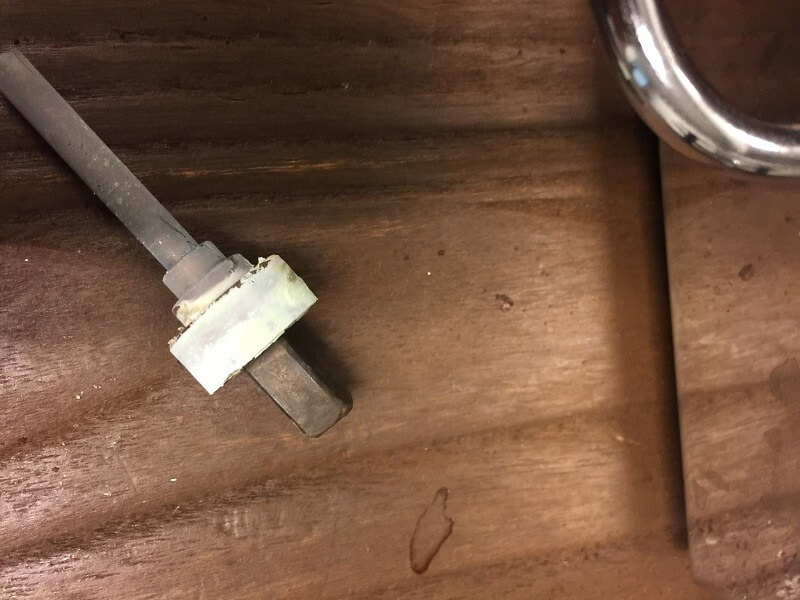
Limescale buildup in your coffee machine can significantly impair the functionality of critical components.
For example, if limescale accumulates on the pressure sensors, they may not accurately detect pressure levels, causing the heating element to overheat and potentially burn out. Likewise, valves clogged with limescale can impede the normal flow of water. Some of the hoses are only 0.8mm wide and it requires only a small amount of limescale to cause a malfunction. In machines that are directly connected to a water supply, this can prevent valves from sealing correctly, which might lead to the boiler overfilling and pose a risk of flooding.
Such complications can set off a series of failures, resulting in expensive repairs that could require a comprehensive overhaul of the system. It’s crucial to proactively manage these risks to prevent severe damage and extend the lifespan of your equipment.
How long does it take for limescale to form?
We have observed instances where users, used bottled mineral water or water filtration systems that reintroduce minerals, experience multiple issues within months, making the interiors appear as if they have been used for years.
Similar to cancer, some users can be luckier; we’ve encountered instances where machines with boilers full of limescale continued functioning for a decade. However, these cases are rare, and such luck is bound to run out. More often, we see the less fortunate individuals whose machines succumb to even a tiny speck of limescale. Sometimes, just a small amount of limescale in a valve is enough to cause the machine to malfunction.
We have yet to meet a user who regrets using a water softener, but we have met many who regret not using one. Investing in water softeners or treating the water can effectively prevent hefty service bills.
Can I just descale?
Descaling, which involves the use of food-grade acids to dissolve limescale, is often promoted by online content creators as an effective maintenance solution. However, it should only be undertaken as a last resort in severe cases. While it may offer limited benefits, there are significant risks and limitations associated with the process, which must be carefully considered.
If your machine has a current issue due to limescale, it is unlikely that doing a descaling at this point will resolve the issue.
Limitations and Risks of Descaling
- Incomplete Limescale Removal
If you believe descaling will completely eliminate all limescale from your machine, you may be disappointed. Most descaling agents, typically weak acids like citric acid or vinegar. They often struggle to penetrate thick deposits or dissolve them entirely. Furthermore, many descalers fail to reach critical areas, such as the top part of the boiler where sensors (e.g.: pressure and temperature sensors) are located. This can leave users with a false sense of security while vital components remain untreated and prone to limescale buildup. - Residual Acid and Corrosion
It is not uncommon for users to inadequately rinse out descaling agents. Residual acid left in the machine can actively corrode internal components, leading to permanent damage, including leaks and malfunctions. This highlights the critical need for thorough rinsing after descaling. - Risk of Component Damage from Hot Water
Many weak descalers require heating to enhance their effectiveness, but introducing hot water into the machine can cause the cold water inlet connectors to expand and detach the hose, resulting in significant leaks. For cold-effective descalers, products like Pulycaff Liquid Descaler are recommended, as they react faster and are safer to use. - Difficulty with Different Limescale Types
While weak acids may effectively dissolve limescale composed of calcium carbonate (CaCO₃) or magnesium carbonate (MgCO₃), they act too slowly and might not reach all areas of the machine. Certain descalers, such as Pulycaff Liquid Descaler, can improve effectiveness due to their rapid reaction time. However, most descalers struggle with calcium sulfate (CaSO₄), a harder form of limescale that often develops in machines with frequent steam wand use. Steam vaporizes water but leaves behind concentrated minerals in the boiler, leading to the formation of calcium sulfate, which is highly resistant to descaling agents. - Clogging of Valves and Components
In cases where limescale flakes off instead of dissolving completely, solid residues can clog valves and disrupt water flow. This can lead to irregular water pressure, ineffective sealing, and potential damage to sensitive components. - Corrosion of Metal Components
Prolonged exposure to acidic descaling agents can corrode metals such as brass and copper, which are commonly used in fittings and boilers. While some brands, such as Bezzera, use food-grade brass with low lead content and protective plating, even these materials can degrade under aggressive descaling conditions. - Pump and Heating Element Damage
The demanding descaling process can overwork vibration pumps, which have specific duty cycles. For example, pumps in professional machines operate on a 2:1 duty cycle (two minutes of operation followed by one minute of rest). Overheating during descaling may result in pump failure. Additionally, strong or overly concentrated descalers can corrode heating elements or damage gauges. Certain risky methods of descaling, such as disconnecting water probes could cause the boiler to overfill and damage the gauges or certain components. - Voiding of Warranty
Most manufacturers, including Bezzera, explicitly void warranties for damage caused by limescale or descaling. Limescale buildup is considered misuse, akin to using cooking oil in a petrol engine. This policy reflects the corrosive and potentially damaging nature of descaling, which can cause severe issues when mishandled.
Preventive Measures as the Best Defense
The most effective strategy against limescale formation is prevention. This can be achieved by using properly softened or filtered water, which minimizes mineral content and reduces the need for descaling. Regular maintenance and proactive water management are far safer and more reliable than relying on descaling as routine practice.
By limiting descaling to only the most severe cases and adopting preventive measures, users can preserve their machines’ performance and longevity, avoid costly repairs, and prevent voided
If you are not aware, damages due to limescale and the descaling process voids the warranty for most high-end machine. The descaling process can be dangerous if incorrectly done.
Difficult to descale 100%
If you believe that descaling will completely remove all limescale from your machine, you may be disappointed.
Descalers cannot access every part of the machine, particularly the top of the boiler, where limescale frequently accumulates. Contrary to what some might assume—that limescale only forms where water directly contacts—the reality is that limescale commonly develops on components located on top of the boiler.
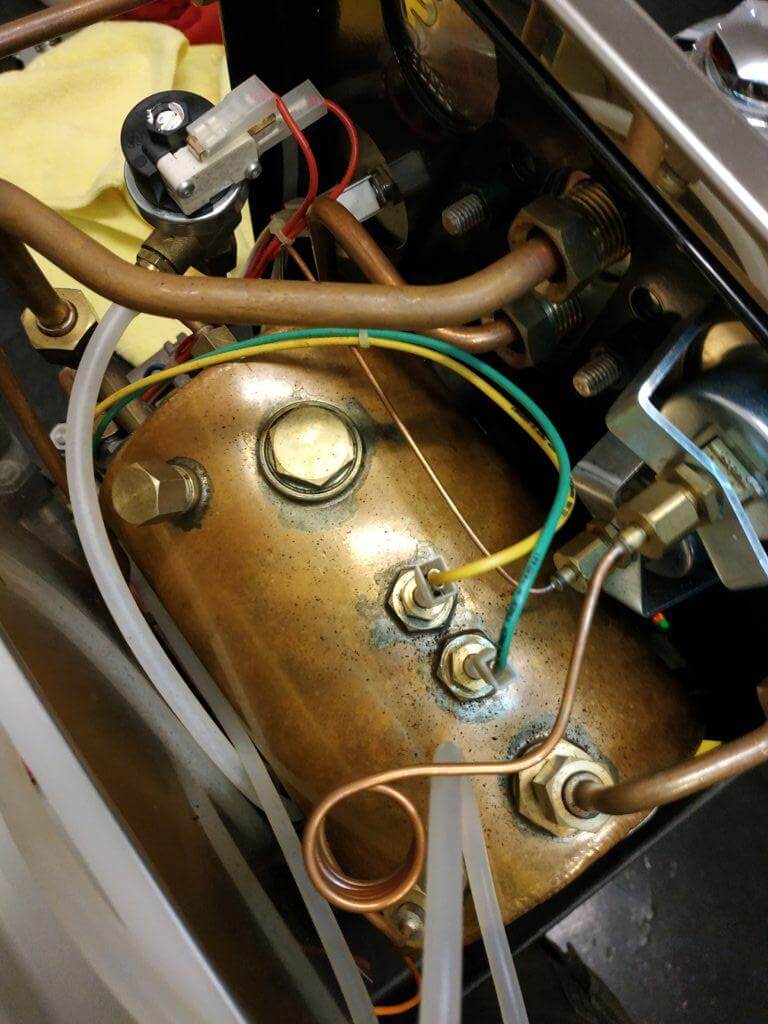
These components include water probes that sense water or temperature, relief valves that bleed excess air, safety valves that prevent the machine from exploding, and the pressurestat that regulates pressure and temperature in the boiler. The hoses to the gauges are only 0.80mm wide. Descalers also fail to clean certain valves that only open under specific conditions, potentially making the effort ineffective in addressing the core issues.
Some technicians opt to dismantle every fitting, tube, and the boiler itself, submerging everything but such aggressive descaling method is very corrosive and expensive as it requires the technician to dismantle the entire boiler.
WHAT SHOULD I DO?
Flush your boiler regularly
One recommendation we give to users is to empty the boiler every 2 to 6 months and refill it with fresh softened water. If you frequently use the steam wand, you may need to do this more often to prevent mineral concentration and the formation of calcium sulfate.
If you are currently using water that you know is hard, it should be flushed out immediately and replaced with softened water.
To flush your steam boiler, first heat up the machine until it builds sufficient pressure. Then, turn off the machine and purge all the water using the water wand. Refill the boiler with clean, softened water.
Here’s a good video from whole latte love on how to drain a heat exchanger machine.
If your machine uses a vibration pump, it’s important to refill the boiler gradually to prevent the pump from overheating and potentially getting damaged, given that vibration pumps have a specific duty cycle. We recommend allowing the pump to operate for one minute, then rest for one minute before continuing for another minute.
If you haven’t flushed your boiler for an extended period, don’t be alarmed if the water appears slightly brownish or if you notice some sediment. These sediments originate from the water itself; the machine does not generate them.
Use water softeners
Most water softeners can only reduce the amount of minerals in the water but can’t eliminate it totally. The efficacy of the softener will reduce over time and will require regular maintenance or replacement. If the condition of the water is very hard, you might need a more effective softener or have it replaced more often.
Water softening cartridge (Recommended)
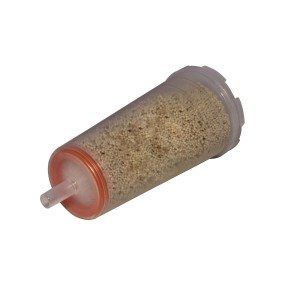
Purchase Bezzera Water Softener here
This method is the simplest and most commonly recommended solution by manufacturers for semi-professional espresso machines, but it is only applicable if the machine draws water from an internal tank. If you plan to connect your machine directly to a tap, this type of cartridge will not be suitable.
Given the water conditions in Singapore, where the hardness is approximately 7 French degrees, the cartridge typically lasts for about 40 liters before needing replacement. If you use mineral water or if the machine is operated in countries with higher water hardness, you may need to replace the softener more frequently. It is crucial to replace any water filters regularly to maintain their effectiveness in softening water and to prevent bacteria from germinating over time.
It’s important to note that most water filters available in Singapore do not have water softening capabilities. Many of them actually perform remineralization, which can lead to significant limescale buildup and potentially cause extensive damage to the machine.
INSTRUCTIONS
Before using, rinse the water softener with clean water for 10 minutes or have it submerged for around 20 minutes. You must not allow the softener to dry up. If the resins inside are dried up, it will no longer be effective.
COMPATIBILITY
For Bezzera machines with a water tank of 4 litres, this includes but not limited to Magica, Mitica, BZ16, Strega, BZ16, Galatea Domus, etc. The water tank will require a modification kit to accept the water softener cartridge.
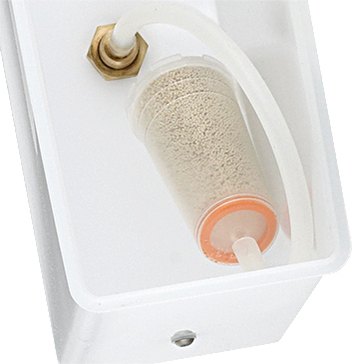
For machines that draw water from a silicone inlet hose like the Bezzera BZ07, BZ09, BZ10, BZ13, Aria, Crema, Expobar Pulser, Brewtus with Vibration pump, Leva EB61, etc. This little cartridge can be attached to the inlet hose directly, you don’t need to do any modification but you should remove the dirt filter before attaching the softener.
For other brands, if your machine is drawing water from a silicone hose like what’s pictured above, then it’s most likely compatible.
Water pitchers with filters
We understand that some brands of water pitchers equipped with built-in filters can marginally reduce the hardness of water. However, the effectiveness of these filters varies significantly between brands and models, making it difficult to evaluate their overall performance.
The filter cartridge within these water pitchers must be replaced regularly to ensure its effectiveness and to prevent bacterial growth. Based on our experience, these filters tend not to last very long. Additionally, users must undertake the extra step of transferring water into the pitcher before it can be used, which we believe is not the most convenient solution.
Since we do not carry these products, we recommend that users consult with the vendor or manufacturer directly to determine the efficacy of these pitchers in softening water.
Many water filters have has activated carbon in it. The filter might release carbon dust, which could get into the boiler and cause valves to clog or be unable to seal.
Water filtration systems
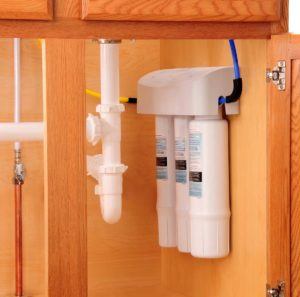
If you are considering plumbing your machine directly to the tap or opting for a whole-house water filtration system, here are some key considerations:
Filtration systems are crucial for espresso machines that are plumbed directly into a water supply, as even small amounts of limescale can compromise the valves that regulate water flow into the boiler. If the seals on these valves are compromised, it significantly increases the risk of flooding due to the boiler becoming overfilled.
Water filtration systems typically consist of large canister filters integrated into the water supply to filter significant volumes of water. However, before purchasing any filters, be aware that most systems on the market, particularly in Singapore, are primarily designed to remove toxins, microbes, metals, and debris, but they are generally ineffective at softening water. Furthermore, they often have limited capacity in this regard.
Moreover, some water filtration systems, like Reverse Osmosis (RO), are extremely thorough and can strip all minerals from the water, producing a result similar to distilled water. Such ultra-pure water is typically used for industrial purposes, but it has also found its way into home and F&B use. The issue with this type of water is that it can be corrosive, gradually eroding metal surfaces, leading to metal toxicity in your drink. Additionally, the ultra-pure nature of this water can prevent machine sensors, such as water probes, from detecting its presence in the boiler, potentially leading to severe machine malfunctions. Many RO systems add minerals back into the water to counteract these effects, but this can lead to limescale formation and is not suitable for espresso machines.
To address the challenges of using overly pure water, some Bezzera espresso machines employ a system that detects water in the tank through electrolysis, which does not function with distilled water, thereby preventing operation under such conditions.
It’s also worth noting that systems using inhibitors to prevent scaling are unsuitable for espresso machines. These are designed for appliances like ice makers and dishwashers, where water fully exits the system, unlike in espresso machines where water is heated to high temperatures and can cause different, more stubborn types of scale.
Moreover, many systems that remineralize water do so to add beneficial minerals back, making the water less corrosive and more healthful. However, this treated water can be detrimental to espresso machines, often leading to severe limescale buildup that is not typically covered under manufacturer warranties as it is considered wear and tear.
When purchasing a commercial filtration system, it is crucial to consult with the manufacturer to verify if the product can effectively soften water and understand its longevity. Effective softeners should clearly state their efficacy and capacity based on varying levels of water hardness. If this information is not readily available, it is likely that the filter is not intended for softening.
Additionally, be wary of filters with activated carbon, which can release carbon dust into your boiler unless properly flushed. These filters also tend to harbor bacteria more readily.
Lastly, understand the capacity of your water softener. Most are effective for only a few hundred to a few thousand liters before needing replacement or regeneration, which can be quickly depleted if used for multiple applications. It is advisable to dedicate the softener solely to the espresso machine and maintain a strict schedule for cartridge replacement or regeneration.
For softeners that can be regenerated using brine, ensure thorough rinsing to remove all salt, as saltwater is highly corrosive to metals.
Distilled water
As previously noted, distilled water is inherently erosive and generally not recommended for regular use in espresso machines. Its erosive nature can strip away metals, potentially introducing toxins into the water, or cause the metal itself to become toxic as protective layers are eroded. Additionally, the water probes in your machine may malfunction if they fail to detect the presence of such pure water in the boiler, potentially leading to significant damage.
However, room temperature distilled water can be effective in gradually dissolving limescale composed of calcium sulfate, although it is not effective against limescale made of calcium bicarbonate and magnesium bicarbonate. In some cases, this property can be beneficial for machines already affected by hard water buildup in the boiler.
It is important to note that some machines from Bezzera, are designed to detect with sensors and reject the use of distilled water to prevent such issues. While it is possible to bypass the water tank’s sensor, we do not recommend this and cannot be responsible for any resulting damages.
Remineralised distilled water
There’s a chemist way of treating distilled water to be usable. This might be the best method and beneficial in many ways. It sounds complicated but it’s not really difficult. Doing this saves you a lot of woes in future. Using this method will mean that limescale will almost never form in the machine. This adds a lot of longevity to the life of your machine. Even when there’s an issue, repairs are likely to be less costly as problems are isolated within the affected components.
In addition to that, the copper wall will form a dark layer of copper oxide which is a good additional protection. Lastly, the user can slightly influence the taste of their espresso as they can manipulate how hard is their water.
To do that, the distilled water must be remineralised by adding some minerals back to negate its erosiveness.
To add the beneficial minerals back into the water. We will suggest using the following formula and should be done with either sodium bicarbonate or potassium bicarbonate.
Using Sodium Bicarbonate(NaHCO₃ aka baking soda)
1. Add 4.2 grams of sodium bicarbonate(baking soda) and dissolve it in 100 mL of distilled water to form a solution.
2. Add 2 mL of this bicarbonate solution to each litre of distilled water. This will give you 84 mg/litre.
Using Potassium Bicarbonate (KHCO₃)
1. Add 10 grams of Potassium Bicarbonate (K₂CO) and dissolve it in 100 mL of distilled water to form a solution.
2. Add 1 mL of this bicarbonate solution to each litre of distilled water. This will give you 100 mg/litre.
Summary
Users should prioritize preventive measures such as water softening to minimize limescale damage. As previously mentioned, it is more cost-effective and simpler to soften the water upfront rather than dealing with limescale removal later. Many water filters sold in Singapore do not actually soften water; in fact, many introduce more minerals into the water, inadvertently hardening the water further.
If, after 5-10 years, you suspect that your machine might be experiencing issues, you can consider returning the machine to us for an inspection and possible replacement of key components. If limescale buildup is minimal, major interventions are often unnecessary. A well-maintained machine can last for decades with only minor part replacements.
If limescale is detected, consider performing targeted light descaling in addition to replacing some components. It is often more effective to replace certain valves altogether rather than cleaning them, as this also provides new seals. Descaling should be considered a last resort due to its potentially harmful and corrosive effects.
For these reasons, it’s generally safer and preferable to enjoy coffee from your own well-maintained machine rather than from a cafe that might descale their machines frequently, that could be using water that is leaching out toxic metal.

